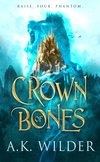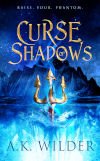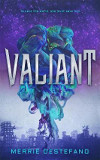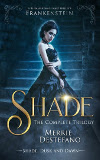 |
| Shark Ship by Daniel Dociu
Hi Everyone,
I wanted to share today three novels that have an underlying theme - sentience vessels. (Shoutout to Helen Lowe and her inspiring post on the Live Ship Trader Series.)
The three books I'm talking about today have their own style and grace, SF wonder and amazement. Each author writes with ability, power and insight. But what really excites me about these novels is their treatment of human and non-human sentience.
What is Sentience?
Is it sapience, intelligence, consciousness? The definition can blur between self-awareness, compassion, identity, ability to suffer and also to adapt, judge and change. But once named 'sentient' everything does, indeed change.
Sentient entities are generally considered deserving of moral rights, respect, and freedom, at lease where these rights are bestowed on humans. So, do these qualities, and therefore rights, belong to humans only? If not, where do we create distinctions?
I love these three books because they each explore these hard questions, though in different ways, yet always juxtaposed to a human main character.
Back in the 60's Ann McCaffrey wrote a short story called The Ship Who Sang. She went on to revise it into a novel and then a series which was also co-written by other SF authors of the time. I'm not sure how the premise would be handled now with more awareness, 60 years later, of persons with disabilities, but still, McCaffrey asks the questions, which is what a good storyteller does.
The Ship Who Sang is about Helva, a human born disabled to the point they only could save her brain. Her life is salvaged by implanting her into the titanium body of an intergalactic ship. When she chooses a human partner, her life unfolds in terrifying and spectacular ways. Ann McCaffrey herself said this was the best story she's ever told...
Toxic by Lydia Kang
Toxic is a standalone, Young Adult SF romance with a touch of fantasy and horror. Written in Kang's ever-engaging style, Toxic is a smart read, one that takes a 'speculative' concept and makes it feel true, right down to the core.
The story focuses on a dying ship and a suicide squad sent to record its demise for the company that made it. In that crew is a young man named Fen who plans to use the last days of his life to make up for a series of wrong choices.
Unknown to all is Hana, the girl left behind by her crew, a girl that has never been out of her room or far from the aqueous folds of her 'bio-mother-ship'... until now.
Toxic asks questions about human and non-human rights, about shifting loyalties and the power of cultural conditioning. But none of that occurs to you while turning the pages. There's too much at stake!
This book, the first in a series of at least one more, still haunts me with its metaphysical questions and real, hard-core truths. The story is, on one level, about a young woman named Seske Kaleigh, heir to the command of a biological, city-size starship carved up from the insides of a spacefaring beast.
Carved up, literally.
While still alive.
The 'beasts' take years to die and there are classes of humans on the city/vessel/beast whose sole purpose in life is to keep it living until they find the next one to replace it. Every possible point and counter-point to the sentient experience is explored in dramatic, spellbinding, heartbreaking ways.
The world--the world-building!--that Drayden creates is so utterly unique, cinematic and so...well, real, you can't tear your eyes off the page, sure is sure is sure.
I highly recommend all of these reads if you want to awaken your mind to the hard questions of science and philosophy, rights, laws and justice of what we deem alive and worthy. But I promise, while you're reading, you won't be 'thinking' at all of these things but instead gripping the edge of your seat until the ride is over.
Do you have a favorite 'non-human sentient' character? I'd love to hear of them in the comments.
***
 Kim Falconer's New YA Fantasy Series is out August 4, 2020 - Crown of Bones. (Writing under A.K. Wilder) Also, check her urban fantasy - The Blood in the Beginning - an Ava Sykes Novel and the SFF Quantum Enchantment Series. You can find Kim on Twitter, Facebook and Instagram. Or pop over and throw the bones on the AKWilder.com site. |
Tuesday, June 16, 2020
Ships that Sing - Three Books Reviewed
by
Kim Falconer
Monday, June 1, 2020
Year of Worldbuilding in Fantasy #5: "Ship of Magic" & The Liveship Traders Series by Robin Hobb
by
Helen Lowe
#YoW Year of Worldbuilding
#WiF Worldbuilding in Fantasy
Introduction:
My blogging theme for 2020 is worldbuilding in Fantasy, chiefly because it's one of the vital elements that holds all the different strands of the genre together. I also believe the distinctive worlds are a big part in what makes Fantasy fiction such fun.
I'm trying to look at a range of Fantasy worlds and types of Fantasy, as well as choosing both older books as well as more recent works. The primary focus, though, is always worldbuilding that has rocked my fantasy-reading world—which means I absolutely can't go past Robin Hobb and her Liveship Traders series, comprising Ship of Magic, The Mad Ship, and Ship of Destiny.
.
.
Ship of Magic & the Liveship Traders Series by Robin Hobb
.
The Liveship Traders is my absolute favourite of Robin Hobb's many series and the worldbuilding is a major reason for that being the case.
Although set in the same world as the earlier Farseer trilogy, which commenced the linked trilogies that make up the larger Fitz and the Fool storyline, the Liveship series is set far to the south of Farseer's Six Duchies. Although the story encompasses a wider geography, the pivotal and defining parts of the worldbuilding encompass the Rain Wilds and Bingtown, with their family-based trading societies, and the sentient liveships that tie them together. Having said this, the Pirates Isles play their part and the whole region is known as The Cursed Shore.
I have always loved sailing ships, and Robin Hobb's Liveship worldbuilding channels the age of sail and many of the historical aspects that accompanied it, including exploration and mercantile expansion, colonialism, slaving, piracy, and the nautical history of the whaling and sealing era. In terms of both the ships and societies, i.e. technology and cultures, the historical ethos "slides" between the 17th and 19th centuries—which I found very 'fresh' when I first read it, and have always enjoyed on rereading, since adventurous and epic fantasy often has a more medieval or archaic world focus.
Fear not, though: this is still fantasy through and through, starting with the highly prized, sentient liveships, which are the only vessels able to survive the acid waters of the Rain Wild river and engage in the lucrative trade of the resource-rich river, including artefacts of the long-vanished but magically and technologically advanced Elderlings. Through the ships, this trade is controlled by the Bingtown and Rain Wild trading families. The magical elements also include the dragon Tintaglia, who plays a vital part in the later story.
Both Bingtown and the Rain Wilds are colonies, but the denizens of the latter are more mysterious, with both men and women always appearing veiled when dealing with their Bingtown counterparts. The reason for this is one of the story's evolving threads, so I shall not reveal more now. In terms of worldbuilding, though, I believe the Rain Wilds are one of the most compelling creations in epic fantasy. The world is not only the liveships and the vast river (think Amazon) with its acidic waters, but the immense impenetrable rainforests that can only be traversed by means of the river. Owing to the challenging and often lethal environment, the mysterious Rain Wild-ers live among the great trees rather than on the forest floor.
In both Bingtown and the Rain Wilds, the societies are shaped culturally and socially by their physical environment, as well as economically—and, as the story progresses through the three books, politically as well, with significant tensions between the colonial societies and the powers that founded them. This also accords with the historical era that gives the Liveship worldbuilding its texture.
But wait, just to underline my point regarding the richness and depth of Robin Hobb's compelling worldbuilding, there's more! The final, major element to the Liveship Traders worldbuilding, which brings in an alien wildness that both contrasts with and enhances the rest, is that of giant sea serpents and their migration across the oceans plied by the liveships and their traders, as well as the pirates. Initially distinct, the story threads of the liveships, the trader communities and pirates, the sea serpents, and the dragon Tintaglia, all come together in the final book.
In short, the worldbuilding of the Liveship Traders trilogy is a longstanding favourite and one that has been a constant traveling companion since I first read Ship of Magic.
Previous Months:
February: The Lion, the Witch & the Wardrobe by CS Lewis
March: A Wizard of Earthsea by Ursula Le Guin
April: Sparrow Hill Road by Seanan McGuire
Subscribe to:
Comments (Atom)






















